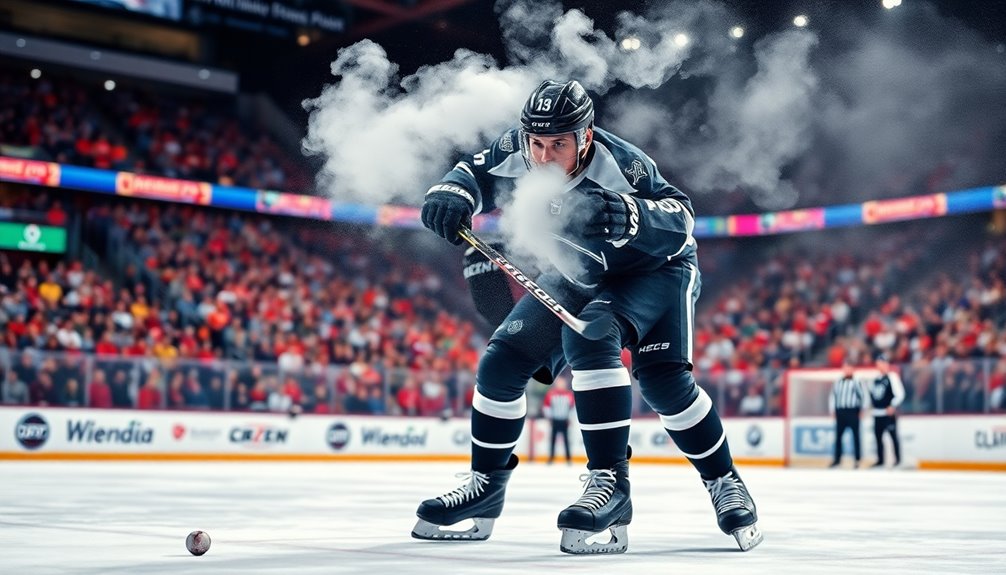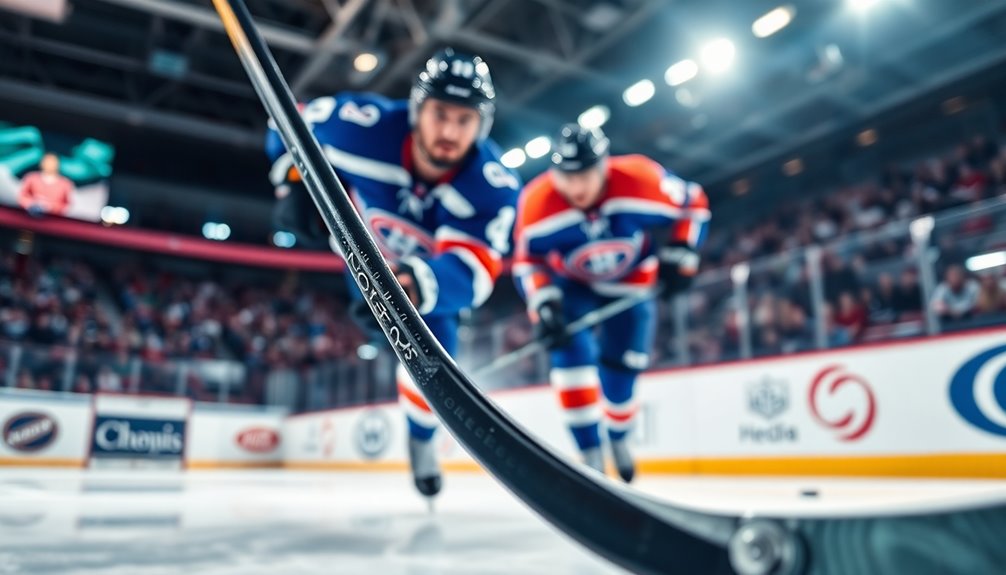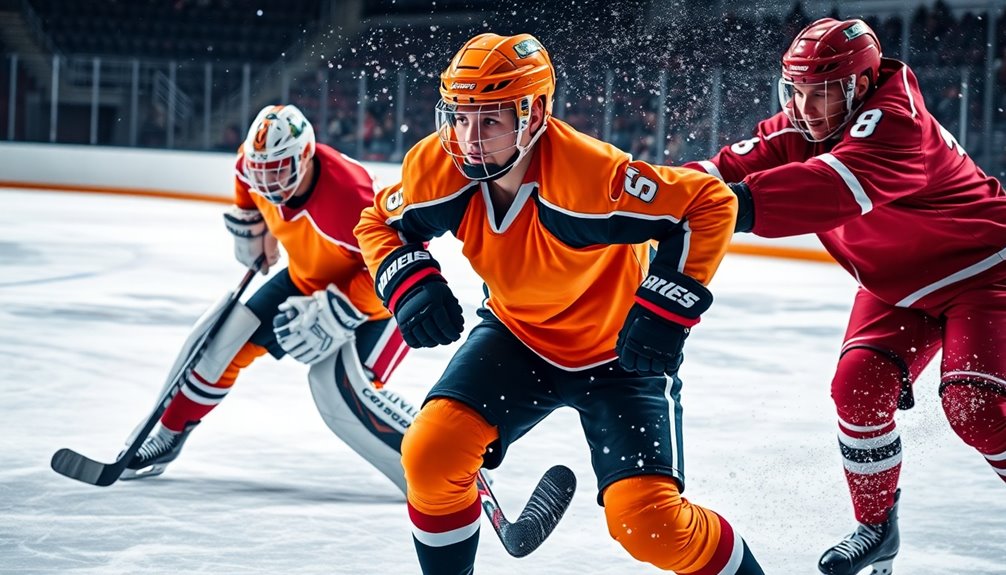
What’s the Best Position in Hockey? A Comprehensive Guide
December 31, 2024Choosing the best position in hockey really comes down to your skills and style. If you're quick and love scoring, you might thrive as a winger. On the other hand, if you enjoy strategy and playmaking, center could be your spot. Defensemen focus on blocking shots and supporting the goalie, while goalies need quick reflexes and strong awareness. Each position has unique responsibilities, so evaluate your strengths and what you enjoy most. Consider trying different roles during practice to find your fit. Stick around, and you'll uncover more about what makes each position special and how it impacts your game.
Overview of Hockey Positions
In hockey, each player has a specific role that contributes to the team's overall strategy. A typical hockey team consists of six positions: one center, two wingers, two defensemen, and one goalie.
Forwards, which include the center and wingers, primarily focus on scoring opportunities and creating offensive plays. The center is essential, acting as a playmaker who handles face-offs and shifts between offensive and defensive duties. Wingers support the center, excel at scoring, and assist in offensive zone plays.
On the other hand, defensemen prioritize defensive duties, protecting the goalie and preventing the opposing team from scoring. They need strong positional play and physicality, while also being able to initiate offensive plays through effective puck possession and shooting from the blue line.
Finally, the goalie serves as the last line of defense. Their responsibilities include stopping pucks, managing rebounds, and directing defensive play, making their performance vital to the team's overall success. Understanding these hockey positions helps you appreciate how each role fits into the broader game strategy, whether you're on the ice or enjoying a match from the stands. Additionally, successful teamwork in hockey mirrors the collaborative nature found in team sports like soccer, where each team consists of 11 players.
Skills Required for Each Position
When you think about hockey positions, it's clear that each role requires a unique set of skills.
Forwards need to skate fast, shoot accurately, and pass effectively to create scoring chances, while defensemen must master positioning and checking to protect their net. Effective communication skills are crucial for defensive players, as they help ensure that all players are aware of their responsibilities during play. Understanding these skill sets helps you appreciate the complexity and teamwork involved in the game. Effective teamwork requires strong communication skills, which enhance coordination among players on the ice. Additionally, mastering tactical awareness can significantly improve a player's effectiveness and contribution to the team's overall performance.
Forward Position Skills
Forwards play a crucial role in hockey, and mastering specific skills is essential for success in this position. To thrive as a forward, you need exceptional skating speed and agility to maneuver quickly around opponents and create scoring opportunities.
Strong puck possession is key, requiring you to develop excellent stickhandling skills to maintain control under pressure. Your shooting ability is critical, as you'll often be the primary scorer on the team. This means you must be comfortable with various shot types, including wrist shots, slap shots, and backhands.
In addition to shooting, effective passing skills are necessary to assist teammates and facilitate quick changes between offense and defense. Good hockey sense is indispensable for forwards. It allows you to read the game, anticipate plays, and make smart decisions.
This understanding helps you manage both your offensive responsibilities and your defensive responsibilities. By honing these forward position skills, you'll not only enhance your overall performance but also contribute greatly to your team's success on the ice.
Defensive Skills Required
Defensemen play a pivotal role in hockey, requiring a unique set of skills to excel on the ice. One of the most essential skills is positioning; you need to be in the right spot to block shots and prevent scoring opportunities.
Your tactical awareness allows you to read the game and anticipate opponents' moves, keeping your defensive zone secure. Strong skating ability is fundamental as well, enabling you to pivot quickly and shift between offensive and defensive plays while maintaining coverage on your opponents.
Checking skills come into play when you engage physically with attackers, helping you regain puck possession and disrupt their offensive strategies. Good decision-making is critical; you must assess situations rapidly to determine whether to join an offensive rush or stay back to protect the goal.
Finally, communication with your teammates is key. You need to coordinate with forwards and goalies to maintain your defensive structure and effectively manage opposing attacks.
Position-Specific Responsibilities

In hockey, each position carries unique responsibilities that are essential for the team's overall success. Centers are pivotal playmakers, orchestrating offensive plays and taking face-offs. They must navigate smoothly between scoring and assisting teammates, ensuring the team remains dynamic.
Wingers, on the other hand, focus on creating scoring opportunities while supporting the center. Their speed and agility are fundamental for maneuvering around opponents and backchecking to fulfill defensive duties effectively.
Defensemen excel in positioning and tactical awareness, working to prevent goals by blocking shots and maintaining puck possession. They also play a key role in shifting play to offense through precise passing.
Goalies serve as the last line of defense, requiring exceptional hand-eye coordination and quick reflexes. Their ability to manage rebounds and communicate with defensemen is essential for organizing defensive strategies. Additionally, they must develop strong communication with teammates to ensure effective defensive coordination.
Each position requires distinct skills: forwards need speed and shooting ability, while defensemen rely on physicality and tactical skills. Goalies must develop reflexes and mental toughness to handle game pressures.
Understanding these position-specific responsibilities will help you appreciate the intricate teamwork involved in hockey.
Assessing Personal Strengths
To find your best position in hockey, you need to identify your key skills and how they align with different roles on the ice.
Think about your skating speed, defensive awareness, or communication abilities and how they can benefit your game. Understanding the key regulations of the sport can also help you determine which position suits your playing style. This position suitability analysis will help you understand where you can excel and contribute most effectively to your team. Additionally, assessing your mental resilience can greatly enhance your performance in various positions on the ice. Developing effective communication skills fosters better team dynamics and can elevate your overall performance in any role.
Identifying Key Skills
Identifying key skills is essential for any hockey player looking to excel in their position. Start by evaluating your skating speed and agility if you're eyeing a forward position. These traits are critical for creating scoring opportunities and evading defenders.
For those considering defenseman roles, focus on your defensive skills, including checking, positioning, and tactical awareness. Analyze your ability to read plays and react quickly, as these skills are significant.
If you're drawn to being a goalie, prioritize your hand-eye coordination and reaction time. These skills directly influence your ability to stop shots and manage rebounds effectively.
Additionally, think about your teamwork and leadership qualities, especially if you're aiming for a center position. These traits impact the overall dynamics and communication within the team.
Lastly, remember that overall physical conditioning and stamina are significant across all positions. Evaluate your endurance levels to guarantee you can perform effectively throughout the game.
Position Suitability Analysis
Understanding your personal strengths is fundamental in determining your best fit in hockey. A position suitability analysis starts with evaluating your skating speed and agility. If you excel in these areas, forward positions may be your best bet, as they rely heavily on speed and offensive creation.
Conversely, if you possess strong defensive skills and situational awareness, a defenseman role could suit you better, as these traits are essential for effective checking and positioning.
For those considering goalie positions, focus on your hand-eye coordination and reaction time. These skills are crucial for successfully stopping shots and handling rebounds.
If you see yourself as a center, strong leadership qualities and outstanding physical fitness are necessary to juggle both offensive and defensive tasks effectively.
Lastly, don't forget about flexibility. Being comfortable adapting to different roles during practice can help you identify your strengths and pinpoint the position that aligns best with your skill set and enjoyment of the game.
Choosing the Right Position

Finding the right position in hockey can greatly enhance your overall experience and performance on the ice. Start by experimenting with different ice hockey positions during practice sessions. This allows you to identify your strengths and discover where you feel most comfortable and effective.
Don't hesitate to seek feedback from coaches and teammates; their insights can help you understand your suitability for specific roles. Additionally, understanding the importance of team coordination can help in choosing a position that complements your teammates' skills. Effective communication on the ice is essential for maintaining team structure and synergy.
When choosing the right position, analyze team needs and dynamics. If your team requires more defensive support, consider shifting to a defenseman role.
It's crucial to select a position that not only meets the team's requirements but also aligns with your personal enjoyment. This connection can greatly boost your motivation and overall player performance. Developing essential skills will also enhance your effectiveness in your chosen position.
Team Dynamics and Communication
Effective communication is the backbone of any successful hockey team. When players communicate effectively, they coordinate plays and shift smoothly between offensive and defensive roles. This awareness of responsibilities on the ice is essential for maximizing scoring opportunities and maintaining puck possession.
Here are a few key aspects of team dynamics and communication:
- Centers: They often drive communication, guiding forwards and defensemen through offensive strategies and ensuring everyone is aligned. Mastering defensive fundamentals helps centers anticipate opponents' moves and fosters a winning mindset that promotes collective success.
- Defensemen and Forwards: They must maintain an open dialogue to cover responsibly, prevent scoring opportunities, and shift effectively.
- Wingers: They need to keep the lines of communication open with centers to optimize scoring chances and fulfill backchecking responsibilities.
When all players engage in effective communication, team dynamics improve greatly. This allows for seamless adjustments to strategies during high-pressure situations. Additionally, the legacy of exclusion in sports has underscored the importance of diverse leadership to foster an inclusive environment where all players feel valued.
Developing a high hockey IQ among players can elevate the team's ability to adapt on-the-fly, fostering a cohesive environment that emphasizes teamwork. By prioritizing communication, you're setting the stage for a successful season, where every player contributes to the greater goal.
Conclusion
In the grand symphony of hockey, each position plays its unique note, creating a harmonious team melody. Whether you're the steadfast goalie, the daring forward, or the strategic defenseman, your contribution shapes the game's rhythm. By understanding your strengths and the responsibilities that come with each role, you'll find your perfect spot on the ice. Embrace your role, communicate with your teammates, and together you'll compose a masterpiece that echoes in the hearts of fans.


